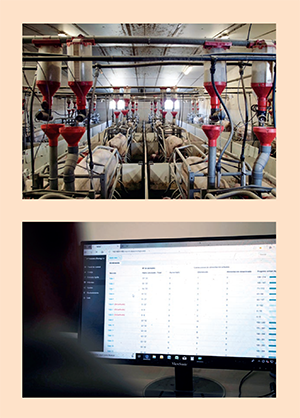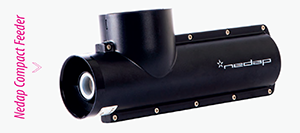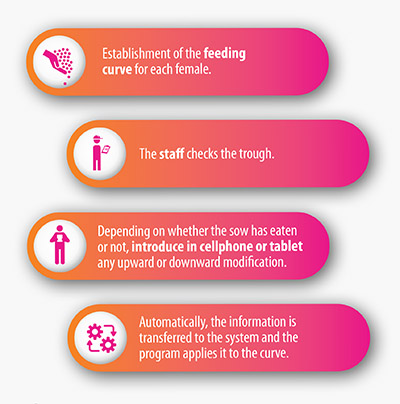We visited a sow farm of the company Bifet Gracia accompanied by its manager, Eduardo Bifet, and by the farm manager, Antonio Aguilar.
The company Bifet Gracia is a family business specialized in the production of pork and beef cattle. We visited their breeding farm with 2,500 sows located in Castillonroy (Huesca), one of the main areas of pig production in Spain.

BIFET GRACIA
Family business, independent producer
Eduardo Bifet speaks proudly of the company’s strategy.
Bifet Gracia is a familiar company that, within the competitive sector of the Spanish pork, has remained an independent producer.
On the one hand, the company has followed a strategy based on carrying out the complete cycle of breeding and fattening of animals. On the other hand, in the use of own installations. Within the context of production and with the cyclical crises it suffers the pig sector, it is not easy to remain as an independent producer in Spain.

We walk around the farm with Antonio Aguilar, who is in charge of the sows’ farm. Antonio had developed his professional activity in the agricultural sector and joined the company 13 years ago, when the farm was in the project phase. He was involved in the construction, which is an advantage since he knows the facility in depth. Then, he went to work on the farm assuming different responsibilities until he reached his current position as head of the breeding farm.
What was the main reason for installing automatic feeders in the maternity ward?
Maternity feeding, formerly with a manual system, had been identified as one of the limiting elements of farm productivity.
The number of times the sows could be fed manually was a limitation to the consumption of feed in the maternity ward and also meant a very important workload for the staff. In addition, to improve productivity we opted to make a change in the farm’s genetics towards more prolific animals.
With this change, looking for more numerous litters, it became even more evident the need to install an automatic feeding system in the maternity ward in order to improve the productive results and the condition of the sows at weaning.
Why did you choose Nedap as your technology provider?
When it came to the decision, Nedap possessed several characteristics that made it a suitable candidate.
Nedap has a very powerful software that matches the management program the farm was already using.
This allows us to cross-check consumer information with the information from the management 
The Nedap Compact Feeder fits perfectly into the dispensers we had in the farrowing units. This is especially important on a farm that was already in full operation. In our case, and in order to interfere less with the day-to-day running of the farm, we opted for the installation of the 512 Nedap Compact Feeder systems when the different rooms were emptied during a complete cycle. Eduardo Bifet
What was your first impression working with the Nedap system?
Once the installation of the Nedap Compact Feeder in the maternity ward was completed, we could see from the beginning how easy it was to work with the system.
The program has a very intuitive and practical learning and the training of the staff is very fast. The daily process is also extremely simple:

We decided to work on the basis of three feeding curves and then raise or low the amount of feed according to each female.
The three curves we work on are the first time gilts, multiparous and another curve that we reserve for sows that have few piglets.
It is important to make clear that anyway the staff must supervise the sows, checking the feeders. But now they can spend more time on tasks that require more attention and we are sure that the sows are fed according to their curve every day.
What advantages have you noticed after installing Nedap Compact Feeder in the maternity ward?
After the installation of the Nedap Compact Feeder automatic system , we increased the feed intake from 3 to 5, although we could even increase it further.
This increase in the number of meals has increased consumption in lactation which makes that:


Another important element to consider is that the installation of the Nedap Compact Feeder has helped us to better adjust consumption and thus reduce feed waste during lactation.
Controlling feeding costs is basic to have an optimal production cost.
Automating feeding in lactation has other advantages. It also allows us to maintain the number of meals, regardless of any limitations of personnel.
Sows are becoming more productive and every portion they receive is important for maintaining the feeding routine and get the maximum consumption. When we were working with the manual system, the days with less staff, like weekends and holidays, it was impossible to give all the meals.
Now, we work with five rations per day:
8.00: 30% of the total
12.00: 15%
17.00: 15%
22.00: 20%
04.00: 20%
We can adjust the feed intake to the year season and in hot periods we can make the sows eat more in the cooler hours, thus maintaining good consumption in those difficult moments.
A great advantage we have observed is the reliability of the machines, something that is basic in the farm equipment.
We installed 512 Nedap Compact Feeders two years ago and we haven’t had any remarkable impact. All those who work on a farm know how important it is to have reliable material, especially when it’s needed for something as important as feeding.
Maintenance has been minimal and we also have Agrogi technical service, who, in case of having any questions, they are always available so we can work it out. Also, most of the incidents are resolved on the phone, which not only makes everything more agile, but also facilitates the care of the farm biosecurity.
We would like to finish talking about the future plans that Eduardo Bifet has for the company.
Our idea is to continue with the strategy that we have maintained until now: to improve the efficiency of the farm. Moreover, we will also continue with the policy of investing in our own facilities with a view to increasing the number of fattening stations, to continue to take care of biosecurity and animal welfare and to be attentive to new technologies. All together in order to continue implementing the best technological developments that allow us to invest with good criteria to improve our pork company.






